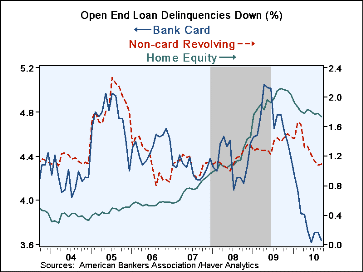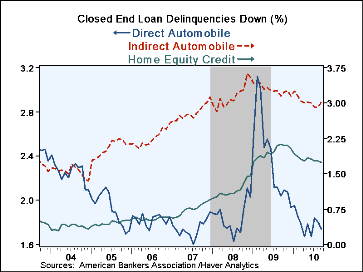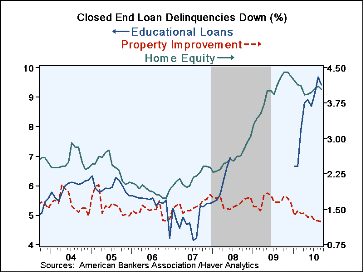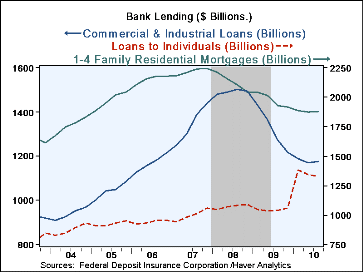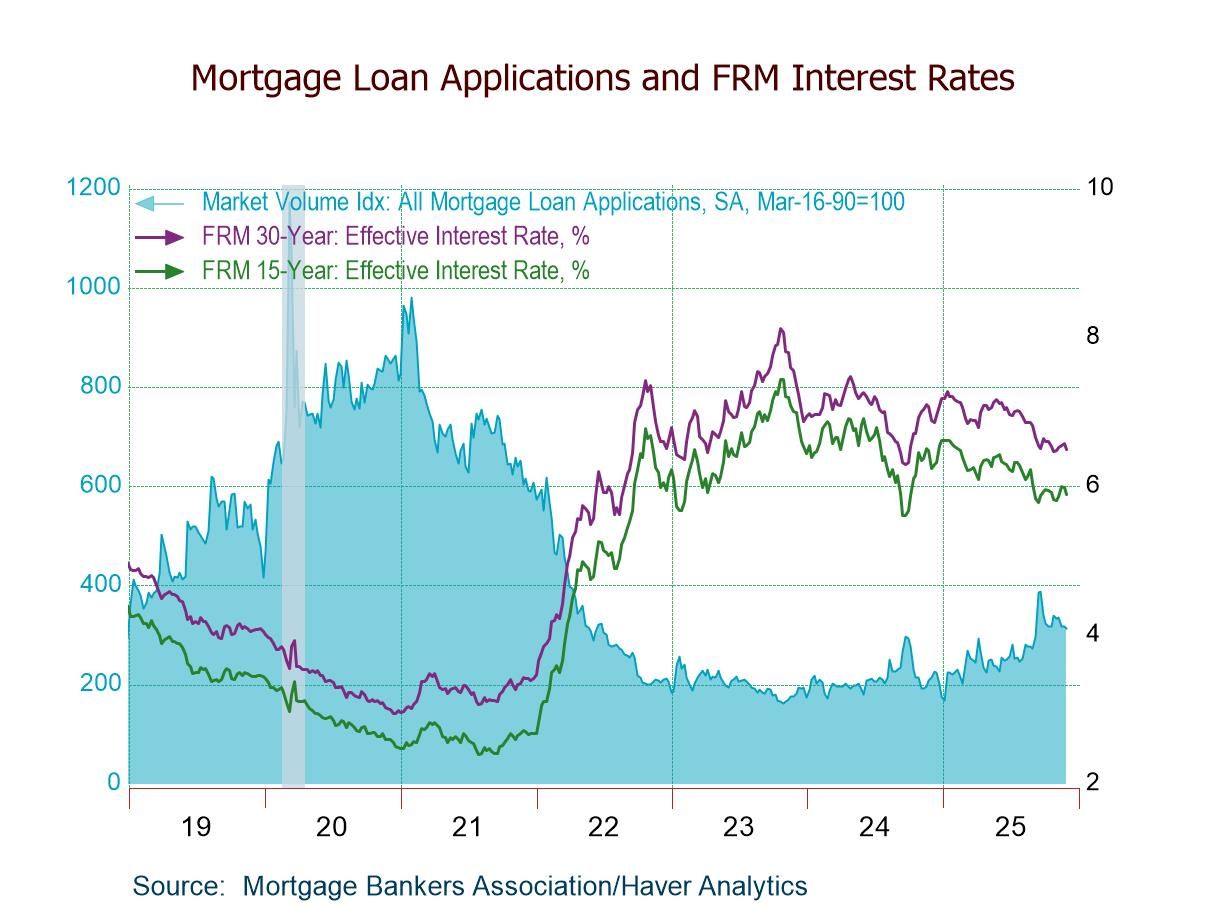 Global| Jan 21 2010
Global| Jan 21 2010U.S. Consumer Credit Delinquencies Remain Lower
by:Tom Moeller
|in:Economy in Brief
Summary
The American Bankers Association indicated last week that loan delinquencies across all types of credit have fallen. Delinquencies in most categories have declined moderately, in some they're down dramatically. Economic recovery [...]
The American Bankers Association indicated last week that loan delinquencies across all types of credit have fallen. Delinquencies in most categories have declined moderately, in some they're down dramatically. Economic recovery underpins this trend. However, as the accompanying charts and table continue to indicate, the declines vary greatly across lines of credit. For the most part, they've been modest and leave delinquencies still quite high.
Amongst open-end loans, the decline in bank-card delinquencies has been most dramatic. Bank card credit delinquency rates have fallen to 3.64% from above-5.0% during the Q2 '09 high. Consumers clearly have pocketed the credit cards that bolstered much of the spending since the mid-1990s, and made a conscious effort to reduce debt. In addition, non-card-revolving credit delinquency rates remain down from the 1990s' peak and near the middle of the range since 2004. Home equity-lines-of-credit delinquencies have shown a more moderate fall.
While off their peaks, delinquency rates on most closed-end loans remain high. Here, the effects of a total unemployment rate near 17% and an average duration of unemployment stuck near 34 weeks are at work. Perhaps most disturbing is the high delinquency rate on personal loans. Its recent 3.7% is down slightly from the 2009 peak but up sharply from under 2.0% as recently as 2007. Delinquency rates on indirect auto loans show a similar pattern of moderate decline but they're still well above the 2004 low. Making home equity loan payments also has proved difficult. The delinquency rate of 4.0% is nearly double that of late-2006, a clear reflection of loan values exceeding property valuations. And then there's the doubling of educational loan delinquencies to 9.4%. The unemployment rate for individuals with a bachelors degree or higher has more-than-doubled to 4.8%, while unemployment for those with less than a bachelors degree remains near 10%. Elsewhere, the sharp decline of direct automobile loan delinquencies may reflect a switch to leasing. The drop in property improvement delinquencies may just reflect a drying up of the business.
The high level of delinquencies has had the greatest effect on bank willingness to lend. Through the third quarter of last year commercial bank & savings institutions lending was falling at a lessened 0.4% annual rate, diminished from the 10.6% rate of decline one year earlier. For construction & development loans, the rate of decline was 27.0% while home-equity loans were falling at an undiminished 3.7% rate. Individuals' loans took a sharp turn to the positive early-last year and were up by one-quarter by Q3. C&I loans stopped falling q/q but were down 7.8% y/y. That quarterly pattern was the same for residential mortgages which remained down 2.5% y/y.
The delinquency rate figures can be found in Haver's DLINQ database.
Household Financial Position from the Federal Reserve Bank of Cleveland can be found here.
| Consumer Credit Delinquency Rate (%) | September | August | July | 2009 | 2008 | 2007 |
|---|---|---|---|---|---|---|
| Open-End Loans | ||||||
| Bank Card | 3.64 | 3.71 | 3.71 | 4.39 | 4.52 | 4.38 |
| Home Equity | 1.74 | 1.78 | 1.77 | 2.04 | 1.46 | 0.96 |
| Non-card Revolving | 1.09 | 1.08 | 1.14 | 1.46 | 1.35 | 1.12 |
| Closed-End Loans | ||||||
| Educational, In Repayment * | 9.41 | 9.69 | 9.08 | -- | 6.93 | 5.39 |
| Home Equity & Second Mortgages | 4.05 | 4.10 | 4.05 | 4.32 | 3.03 | 2.39 |
| Mobile Home | 4.01 | 3.95 | 4.03 | 3.41 | 2.96 | 2.92 |
| Personal Loans | 3.68 | 3.75 | 3.56 | 3.63 | 2.88 | 2.48 |
| Personal Indirect Automobile ** | 3.02 | 2.92 | 2.92 | 3.15 | 3.53 | 3.13 |
| Marine Financing | 2.04 | 2.10 | 2.14 | 1.63 | 2.35 | 1.57 |
| Personal Direct Automobile ** | 1.74 | 1.80 | 1.84 | 1.94 | 2.03 | 1.90 |
| Property Improvement | 1.23 | 1.25 | 1.26 | 1.63 | 1.75 | 1.81 |
* Break in data series in 2008 & 2009
** An indirect loan is a loan that is given to the customer from the dealership who then has to go through a bank. A direct loan is a loan directly from the bank to the customer.
Tom Moeller
AuthorMore in Author Profile »Prior to joining Haver Analytics in 2000, Mr. Moeller worked as the Economist at Chancellor Capital Management from 1985 to 1999. There, he developed comprehensive economic forecasts and interpreted economic data for equity and fixed income portfolio managers. Also at Chancellor, Mr. Moeller worked as an equity analyst and was responsible for researching and rating companies in the economically sensitive automobile and housing industries for investment in Chancellor’s equity portfolio. Prior to joining Chancellor, Mr. Moeller was an Economist at Citibank from 1979 to 1984. He also analyzed pricing behavior in the metals industry for the Council on Wage and Price Stability in Washington, D.C. In 1999, Mr. Moeller received the award for most accurate forecast from the Forecasters' Club of New York. From 1990 to 1992 he was President of the New York Association for Business Economists. Mr. Moeller earned an M.B.A. in Finance from Fordham University, where he graduated in 1987. He holds a Bachelor of Arts in Economics from George Washington University.


